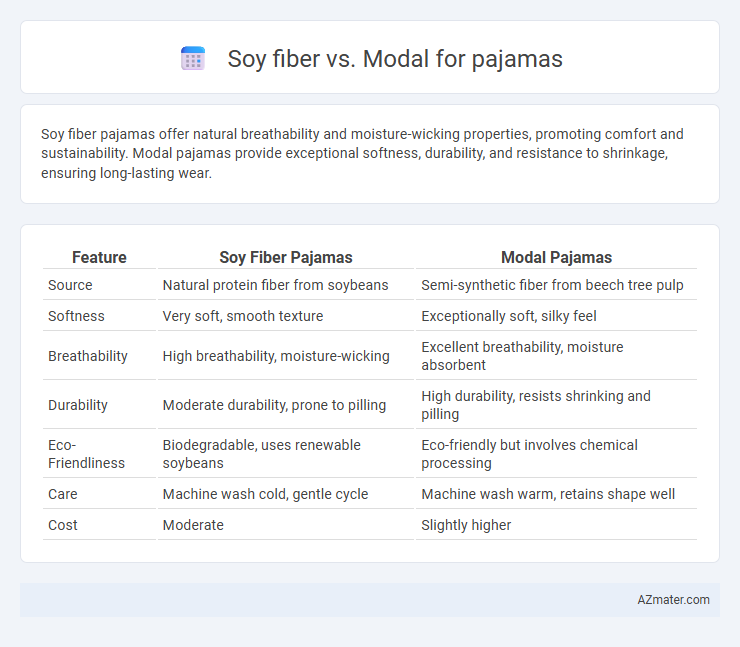Soy fiber pajamas offer natural breathability and moisture-wicking properties, promoting comfort and sustainability. Modal pajamas provide exceptional softness, durability, and resistance to shrinkage, ensuring long-lasting wear.
Table of Comparison
| Feature | Soy Fiber Pajamas | Modal Pajamas |
|---|---|---|
| Source | Natural protein fiber from soybeans | Semi-synthetic fiber from beech tree pulp |
| Softness | Very soft, smooth texture | Exceptionally soft, silky feel |
| Breathability | High breathability, moisture-wicking | Excellent breathability, moisture absorbent |
| Durability | Moderate durability, prone to pilling | High durability, resists shrinking and pilling |
| Eco-Friendliness | Biodegradable, uses renewable soybeans | Eco-friendly but involves chemical processing |
| Care | Machine wash cold, gentle cycle | Machine wash warm, retains shape well |
| Cost | Moderate | Slightly higher |
Introduction to Pajama Fabrics
Pajama fabrics like soy fiber and modal differ significantly in texture and sustainability. Soy fiber, derived from soybean hulls, offers a smooth, eco-friendly option with natural moisture-wicking properties. Modal, a semi-synthetic fabric made from beech tree pulp, provides exceptional softness, breathability, and durability, making both materials ideal for comfortable sleepwear.
What is Soy Fiber?
Soy fiber, derived from the byproducts of soybean processing, offers a sustainable and eco-friendly fabric option known for its softness and breathability, making it ideal for pajamas. Its natural protein content provides excellent moisture-wicking and antimicrobial properties, enhancing comfort during sleep. Compared to modal, which is made from beech tree pulp and prized for its smooth texture and durability, soy fiber pajamas deliver a unique blend of environmental benefits and skin-friendly qualities.
What is Modal?
Modal is a semi-synthetic fiber made from beech tree pulp, known for its exceptional softness, breathability, and moisture-wicking properties, making it ideal for comfortable pajamas. Compared to soy fiber, which is derived from soybean hulls and offers good moisture absorption and eco-friendliness, modal provides superior durability and a smooth, silky texture. Both fibers are sustainable options, but modal's resistance to shrinkage and ease of care make it a popular choice for luxury sleepwear.
Environmental Impact: Soy Fiber vs Modal
Soy fiber, derived from soybean processing byproducts, offers a biodegradable and renewable alternative with low environmental impact due to its utilization of agricultural waste. Modal, produced from beech tree pulp, involves intensive chemical processing but is recognized for its sustainability when sourced from responsibly managed forests with certifications like FSC. The choice between soy fiber and modal for pajamas hinges on factors such as the origin of raw materials, production methods, and end-of-life biodegradability, with soy fiber typically boasting a smaller carbon footprint and modal providing durability with sustainable forestry practices.
Comfort and Softness Comparison
Soy fiber pajamas offer exceptional softness due to the natural protein content that mimics the feel of silk, providing a smooth, breathable fabric ideal for sensitive skin. Modal pajamas are crafted from beech tree cellulose, resulting in a luxuriously soft texture with excellent moisture-wicking properties and durability, which enhances comfort during extended wear. Compared to soy fiber, Modal maintains its softness after multiple washes and offers a slightly cooler touch, making it preferable for those prioritizing long-term comfort and fabric resilience in sleepwear.
Breathability and Moisture-Wicking Properties
Soy fiber pajamas offer exceptional breathability due to their natural spongy texture, allowing air circulation that keeps the skin cool and dry. Modal fabric, derived from beech tree pulp, provides superior moisture-wicking properties by quickly absorbing and releasing sweat, promoting comfort during sleep. Both fibers enhance nighttime comfort, but soy fiber excels in breathability while modal leads in moisture management.
Durability and Longevity
Soy fiber pajamas offer moderate durability with natural resilience, maintaining softness and shape through multiple washes. Modal fabric, derived from beech trees, excels in durability due to its strong fibers, resisting shrinkage and pilling for extended longevity. Pajamas made from modal typically outlast soy fiber counterparts, providing sustained comfort and durability over time.
Skin Sensitivity and Hypoallergenic Qualities
Soy fiber offers excellent breathability and natural moisture-wicking properties, making it ideal for pajamas worn by those with sensitive skin. Modal, derived from beech tree pulp, is smooth and hypoallergenic, reducing irritation risks and promoting comfort for allergy-prone individuals. Both fabrics excel in softness and durability, but soy fiber's superior moisture management often benefits people prone to skin sensitivities more effectively.
Care and Maintenance of Pajamas
Soy fiber pajamas require delicate care, including hand washing or using a gentle cycle with cold water to maintain their softness and prevent shrinking. Modal pajamas are more durable and easier to maintain, often machine washable in cold or warm water without losing shape or color. Both fabrics benefit from air drying and avoiding high heat to preserve fabric integrity and prolong the lifespan of pajamas.
Choosing the Best Fabric for Your Pajamas
Soy fiber offers exceptional softness and breathability, making it ideal for pajamas designed to keep you cool and comfortable throughout the night. Modal fabric boasts excellent moisture-wicking properties and durability, ensuring longevity and a silky touch that enhances sleep quality. Selecting pajamas made from soy fiber is perfect for sensitive skin, while modal suits those seeking a combination of luxury and practical wear resistance.

Infographic: Soy fiber vs Modal for Pajama
 azmater.com
azmater.com